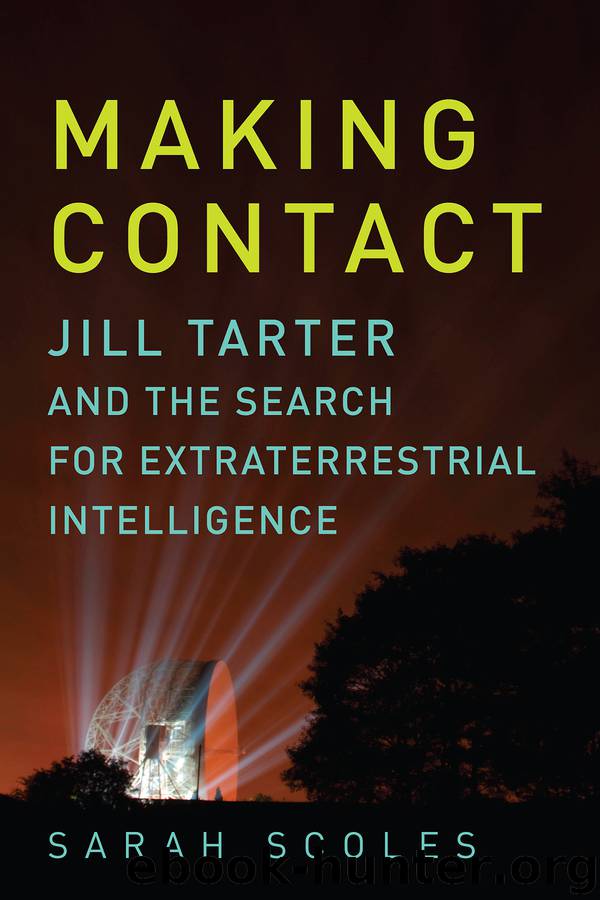Making Contact by Sarah Scoles

Author:Sarah Scoles
Language: eng
Format: epub
Publisher: Pegasus Books
Published: 2017-03-04T16:00:00+00:00
Before the SETI scientists could find smart-looking signals from space, though, they needed to understand the strange signals the universe produces naturally, and the signals humans put out with their satellites, sitcoms, and station wagons. SETI needs to be able to distinguish these natural and human-made radio waves from the ones that might come from extraterrestrial beings. As the SETI team began to plan an actual search for extraterrestrial intelligence, Tarter focused on finding the narrowest-band radio waves that came from astronomical objects, not biological beings. Most very narrow signals that we know of are synthetic—made by us. So SETI scientists thought extraterrestrials might compress their signals, too. But to figure out how concentrated a signal had to be to look “smart,” Tarter needed to know how concentrated nature made its own signals.
Every color we see is actually just a particular wavelength of light. Red is 650 nanometers; yellow is 580 nanometers. Our sun looks yellow, but it doesn’t just emit yellow light. It shines across a wide spectrum of colors, with yellowish being the brightest. Lasers, on the other hand, send out “coherent” light, much more focused around just one wavelength. Space has its own lasers (although space chose to call them masers, which stands for microwave amplification by stimulated emission of radiation) made of radio waves, which are the most coherent radio sources in the universe. You can’t see them with your eyes, because your eyes can’t detect radio waves. But if your eyes were radio telescopes, the masers would look just like lasers. For one figure who has been important to SETI and is famously depicted in fictional form in the movie Contact, radio waves are like visible light waves. Kent Cullers, the blind astronomer who worked on SETI beginning in 1985 and contributed key signal detection hardware and software, truly gets radio waves. “My sensory connection to the wider universe is not vision but radio waves,” Cullers said in a SETI Institute interview. “. . . Because Braille can now represent mathematics and diagrams, not only the world but also the universe is open to blind people.”
SETI’s spectrometer, with which Cullers worked, could split an incoming radio signal into tinier channels than any that came before. The scientists could tell, for the first time, exactly how compressed masers’ radio waves are. Then, in the future, if a SETI instrument picked up anything more compressed than that, the scientists would know the signal was either from technologically competent extraterrestrials who squish their signals like we do, from some undiscovered kind of celestial object, or from humans. They called this “defining the SETI sandbox.” And, like curious kids, they wanted to play in it. But getting time on big telescopes was hard when you just wanted to test something and not do a more meaningful experiment. Usually, for national telescopes, a jury of scientist peers ranks written-up proposals and allocates the time to the worthiest projects. SETI didn’t often make the cut.
NASA, wanting to help the project they
Download
This site does not store any files on its server. We only index and link to content provided by other sites. Please contact the content providers to delete copyright contents if any and email us, we'll remove relevant links or contents immediately.
| Aerodynamics | Aircraft Design & Construction |
| Astronautics & Space Flight | Avionics |
| Gas Dynamics | Propulsion Technology |
Whiskies Galore by Ian Buxton(41879)
Introduction to Aircraft Design (Cambridge Aerospace Series) by John P. Fielding(33064)
Small Unmanned Fixed-wing Aircraft Design by Andrew J. Keane Andras Sobester James P. Scanlan & András Sóbester & James P. Scanlan(32743)
Craft Beer for the Homebrewer by Michael Agnew(18140)
Turbulence by E. J. Noyes(7935)
The Complete Stick Figure Physics Tutorials by Allen Sarah(7307)
Kaplan MCAT General Chemistry Review by Kaplan(6866)
The Thirst by Nesbo Jo(6826)
Bad Blood by John Carreyrou(6552)
Modelling of Convective Heat and Mass Transfer in Rotating Flows by Igor V. Shevchuk(6391)
Learning SQL by Alan Beaulieu(6209)
Weapons of Math Destruction by Cathy O'Neil(6142)
Man-made Catastrophes and Risk Information Concealment by Dmitry Chernov & Didier Sornette(5921)
Digital Minimalism by Cal Newport;(5663)
Life 3.0: Being Human in the Age of Artificial Intelligence by Tegmark Max(5474)
iGen by Jean M. Twenge(5366)
Secrets of Antigravity Propulsion: Tesla, UFOs, and Classified Aerospace Technology by Ph.D. Paul A. Laviolette(5309)
Design of Trajectory Optimization Approach for Space Maneuver Vehicle Skip Entry Problems by Runqi Chai & Al Savvaris & Antonios Tsourdos & Senchun Chai(5011)
Pale Blue Dot by Carl Sagan(4911)
